Nestled between the majestic Himalayas and the Indian plains, Nepal is a land of rich biodiversity and stunning landscapes. The country is home to a variety of wildlife and bird species, making it an ideal destination for jungle safaris. In this blog, we'll provide complete information on jungle safaris in Nepal, covering the top national parks, the best time to visit, and the types of safari activities available.
If you need any further information, please contact us by email: at [email protected], Phone: at +977- 985 100 5129 (WhatsApp)
Direct Call: +977-9851005129 (Nepal) and +1 916 794 8443 (USA)
Top National Parks for Jungle Safaris in Nepal
Nepal is home to several national parks and wildlife reserves that offer fantastic opportunities for jungle safaris.
The top national parks for jungle safaris in Nepal include:
Chitwan National Park
A Chitwan National Park safari offers an unforgettable experience for wildlife enthusiasts and nature lovers. Chitwan, a UNESCO World Heritage site, is one of the most popular national parks in Nepal and is home to diverse landscapes, including grasslands, forests, and riverine habitats, which support a wide variety of flora and fauna.

Here's an overview of what you can expect during a Chitwan National Park safari:
Wildlife: Chitwan National Park is home to numerous species, including the endangered one-horned rhinoceros, Bengal tigers, Asian elephants, sloth bears, and various species of deer, monkeys, and reptiles. The park is also a paradise for birdwatchers, with over 500 bird species recorded.
Safari activities: Chitwan offers a range of safari activities, including jeep safaris, canoe rides, jungle walks, and birdwatching tours. Jeep safaris provide a comfortable way to explore the park and cover larger distances, increasing your chances of spotting wildlife. Canoe rides along the Rapti and Narayani rivers offer opportunities to observe aquatic species like crocodiles and various water birds. Jungle walks and birdwatching tours allow you to explore the park on foot and focus on smaller wildlife, plants, and birdlife.
Accommodation: Chitwan National Park has a range of accommodations to suit different budgets and preferences, from basic lodges to luxury resorts. Many lodges and resorts are located in the buffer zone or on the outskirts of the park and offer safari packages, including accommodation, meals, and guided activities.
Getting there: Chitwan National Park is easily accessible from Kathmandu and Pokhara. You can fly from Kathmandu to Bharatpur Airport (about a 25-minute flight) and then drive for about an hour to reach the park. Alternatively, you can take a private vehicle or tourist bus from Kathmandu or Pokhara, which takes approximately 5-6 hours.
Best time to visit: The best time to visit Chitwan National Park is during the dry season from October to March, when the weather is more stable, and wildlife sightings are more frequent.

A safari in Chitwan National Park offers an incredible opportunity to experience Nepal's diverse landscapes and wildlife up close. With its rich biodiversity and range of activities, Chitwan is a must-visit destination for nature lovers and wildlife enthusiasts.
If you need any further information, please contact us by email: at [email protected], Phone: at +977- 985 100 5129 (WhatsApp)
Bardia National Park
A Bardia National Park safari offers an immersive experience in one of Nepal's largest and most undisturbed protected areas. Situated in the Terai region, Bardia is known for its diverse landscapes, including riverine forests, grasslands, and savannas, which support a wide variety of flora and fauna. Being less crowded than Chitwan National Park, Bardia provides a more remote and off-the-beaten-path adventure.
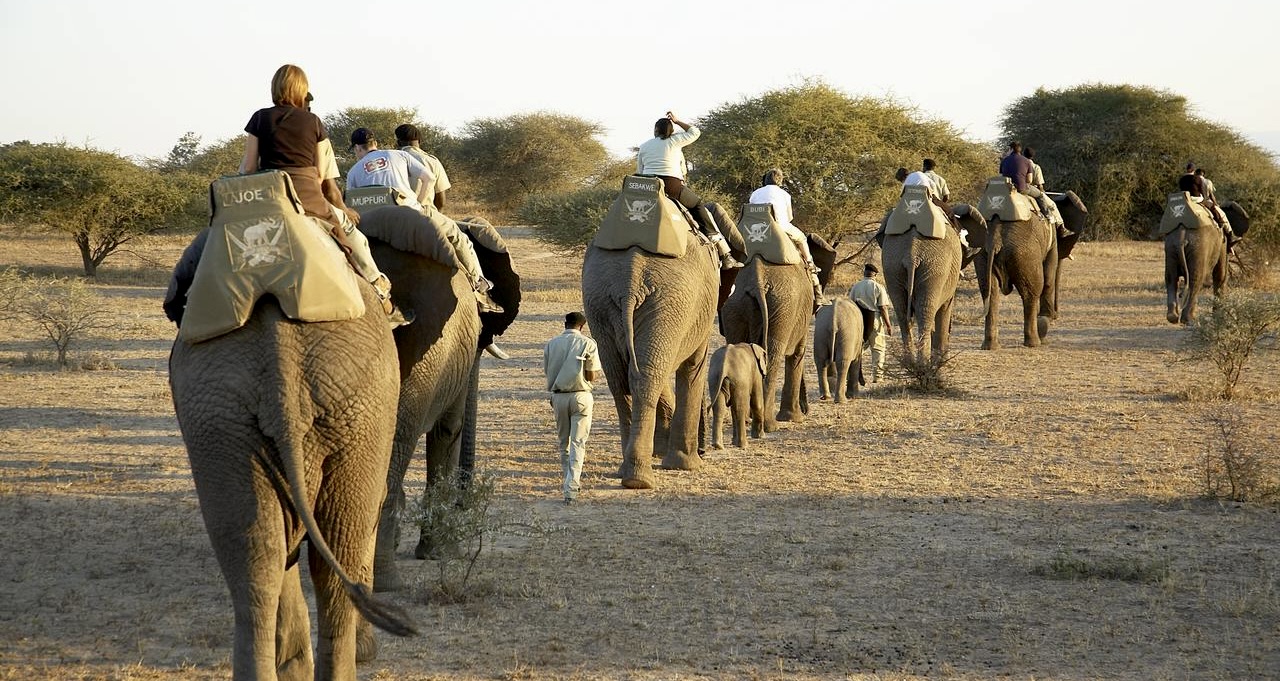
Here's an overview of what you can expect during a Bardia National Park safari:
Wildlife: Bardia is home to many species, including the endangered Bengal tiger, one-horned rhinoceros, Asian elephants, and Gangetic dolphins. Other wildlife includes various species of deer, monkeys, sloth bears, and reptiles. Bardia is also an excellent destination for birdwatching, with over 400 bird species recorded.
Safari activities: Bardia offers a range of safari activities, such as jeep safaris, elephant safaris, jungle walks, and river activities. Jeep safaris provide a comfortable way to explore the park and increase your chances of spotting wildlife. Elephant safaris offer a unique perspective on the park's landscapes and wildlife. Jungle walks led by experienced naturalists provide an opportunity to learn about the park's flora and fauna in more detail. River activities, such as rafting or canoeing, offer chances to observe aquatic species like crocodiles and Gangetic dolphins.
Accommodation: Bardia National Park has various accommodation options, from basic lodges to more upscale resorts. Many lodges and resorts are located near the park and offer safari packages that include accommodation, meals, and guided activities.
Getting there: Bardia National Park can be reached by flying from Kathmandu to Nepalgunj Airport (about an hour-long flight) and then driving for approximately 2-3 hours to reach the park. Alternatively, you can take a private vehicle or tourist bus from Kathmandu, which takes about 12-15 hours.
Best time to visit: The best time to visit Bardia National Park is during the dry season from October to March, when the weather is more stable, and wildlife sightings are more frequent. The months of April and May can also be rewarding, as the water sources start to dry up and animals gather around the remaining waterholes.
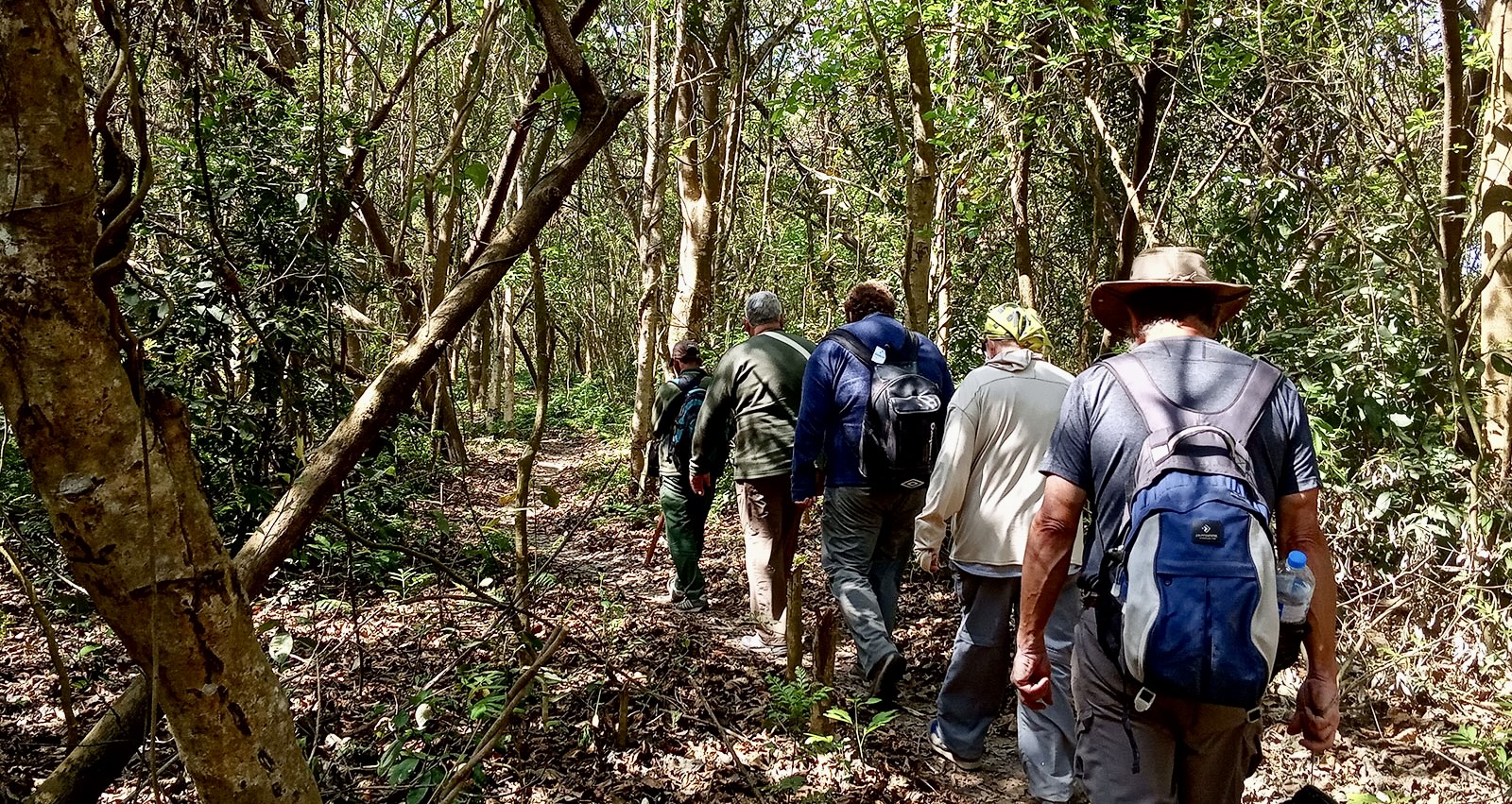
A safari in Bardia National Park offers a memorable experience for nature and wildlife enthusiasts looking for a less-crowded and off-the-beaten-path adventure in Nepal. With its diverse landscapes and abundant wildlife, Bardia is a fantastic destination for an authentic jungle safari experience.
Shuklaphanta National Park
A Shuklaphanta National Park safari offers a unique and less-explored wildlife experience in Nepal. Located in the far-western Terai region, Shuklaphanta is the country's smallest national park, but it boasts diverse landscapes, including grasslands, forests, and wetlands that support a wide variety of flora and fauna.

Here's an overview of what you can expect during a Shuklaphanta National Park safari:
Wildlife: Shuklaphanta is home to many species, including the endangered swamp deer, Bengal tiger, one-horned rhinoceros, and Asian elephants. Other wildlife includes various species of deer, monkeys, sloth bears, and reptiles. The park is also an important destination for birdwatching, with over 350 bird species recorded, including several migratory species.
Safari activities: Shuklaphanta offers a range of safari activities, such as jeep safaris, jungle walks, and birdwatching tours. Jeep safaris provide a comfortable way to explore the park and increase your chances of spotting wildlife. Jungle walks led by experienced naturalists provide an opportunity to learn about the park's flora and fauna in more detail. Birdwatching tours focus on the park's rich birdlife and offer an excellent opportunity for avid birdwatchers.
Accommodation: Shuklaphanta National Park has limited accommodation options compared to Chitwan and Bardia, but there are a few lodges and homestays near the park. These lodges and homestays typically offer safari packages that include accommodation, meals, and guided activities.
Getting there: Shuklaphanta National Park can be reached by flying from Kathmandu to Dhangadhi Airport (about an hour and 10 minutes flight), and then driving for approximately 1.5 hours to reach the park. Alternatively, you can take a private vehicle or tourist bus from Kathmandu, which takes about 14-16 hours.
Best time to visit: The best time to visit Shuklaphanta National Park is during the dry season from October to March, when the weather is more stable, and wildlife sightings are more frequent.
A safari in Shuklaphanta National Park offers a unique opportunity to experience Nepal's wildlife in a less-visited and tranquil setting. With its diverse landscapes and abundant wildlife, Shuklaphanta is an excellent destination for nature lovers and wildlife enthusiasts seeking an off-the-beaten-path adventure.
If you need any further information, please contact us by email: at [email protected], Phone: at +977- 985 100 5129 (WhatsApp)
Parsa Wildlife Reserve
Parsa Wildlife Reserve, located in the south-central lowland Terai region of Nepal, offers a unique wildlife experience that is relatively less explored compared to Chitwan and Bardia National Parks. Parsa is the largest wildlife reserve in the country, covering diverse landscapes, including tropical and subtropical forests, grasslands, and riverine ecosystems that support a wide variety of flora and fauna.

Here's an overview of what you can expect during a Parsa Wildlife Reserve safari:
Wildlife: Parsa Wildlife Reserve is home to various species, including the endangered Bengal tiger, one-horned rhinoceros, Asian elephants, and sloth bears. Other wildlife includes different species of deer, monkeys, leopards, and reptiles. Parsa is also an excellent destination for birdwatching, with over 500 bird species recorded.
Safari activities: Parsa offers a range of safari activities, such as jeep safaris and jungle walks. Jeep safaris provide a comfortable way to explore the reserve and increase your chances of spotting wildlife. Jungle walks led by experienced naturalists provide an opportunity to learn about the reserve's flora and fauna in more detail.
Accommodation: Parsa Wildlife Reserve has limited accommodation options compared to Chitwan and Bardia. However, there are a few lodges, resorts, and homestays near the reserve that offer safari packages, including accommodation, meals, and guided activities.
Getting there: Parsa Wildlife Reserve can be reached by flying from Kathmandu to Simara Airport (about a 20-minute flight) and then driving for approximately 1.5 hours to reach the reserve. Alternatively, you can take a private vehicle or tourist bus from Kathmandu, which takes about 6-7 hours.
Best time to visit: The best time to visit Parsa Wildlife Reserve is during the dry season from October to March when the weather is more stable, and wildlife sightings are more frequent.
A safari in Parsa Wildlife Reserve offers a unique opportunity to experience Nepal's diverse landscapes and wildlife in a less-crowded and off-the-beaten-path setting. With its rich biodiversity and relatively untouched environment, Parsa is an ideal destination for nature lovers and wildlife enthusiasts seeking an authentic jungle safari experience.
Koshi Tappu Wildlife Reserve
Koshi Tappu Wildlife Reserve, located in the eastern Terai region of Nepal, is a unique and lesser-explored wildlife destination. Established primarily as a waterbird habitat, Koshi Tappu is an important Ramsar Site (wetland of international importance) and boasts diverse landscapes, including wetlands, grasslands, and forests, which support a wide variety of flora and fauna.
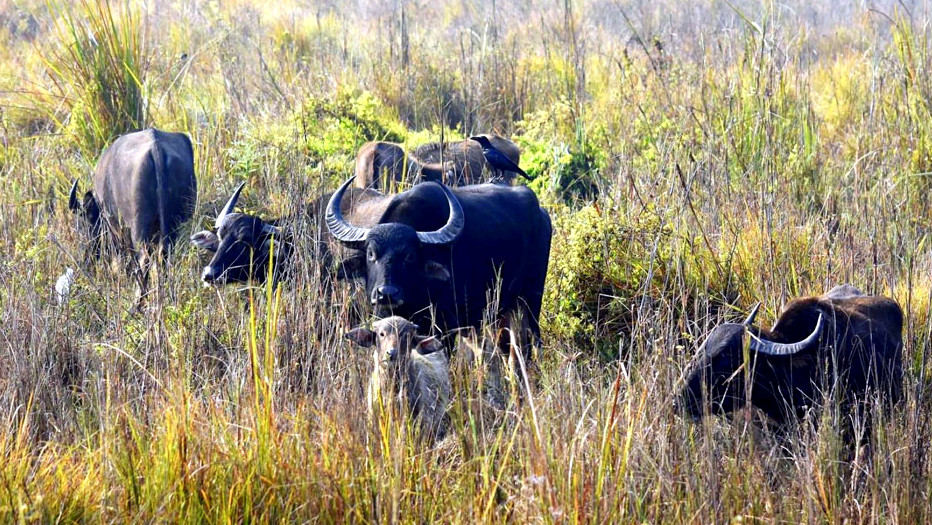
Here's an overview of what you can expect during a Koshi Tappu Wildlife Reserve safari:
Wildlife: Koshi Tappu is a paradise for birdwatchers, with over 490 bird species recorded, including several migratory species. The reserve is also home to the endangered wild water buffalo (Arna) and other wildlife, such as various species of deer, blue bulls, Gangetic dolphins, crocodiles, and otters.
Safari activities: Koshi Tappu offers a range of safari activities, including birdwatching tours, jungle walks, and boat rides. Birdwatching tours focus on the reserve's rich birdlife and provide an excellent opportunity for avid birdwatchers to spot both resident and migratory species. Jungle walks led by experienced naturalists offer an opportunity to learn about the reserve's flora and fauna in more detail. Boat rides along the Koshi River and its floodplains give you a chance to observe aquatic species and enjoy the serene landscapes.
Accommodation: Koshi Tappu Wildlife Reserve has limited accommodation options, but there are a few lodges, resorts, and tented camps near the reserve that cater to visitors. These accommodations typically offer safari packages that include accommodation, meals, and guided activities.
Getting there: Koshi Tappu Wildlife Reserve can be reached by flying from Kathmandu to Biratnagar Airport (about a 45-minute flight) and then driving for approximately 2-3 hours to reach the reserve. Alternatively, you can take a private vehicle or tourist bus from Kathmandu, which takes about 10-12 hours.
Best time to visit: The best time to visit Koshi Tappu Wildlife Reserve is during the dry season from October to March when the weather is more stable, and bird sightings are more frequent. Migratory bird species are usually present from November to February.
A safari in Koshi Tappu Wildlife Reserve offers a unique opportunity to experience Nepal's diverse landscapes and wildlife, particularly for birdwatching enthusiasts. With its rich birdlife and tranquil wetland setting, Koshi Tappu is an excellent destination for nature lovers and wildlife enthusiasts seeking a less-crowded and off-the-beaten-path adventure.
Best Time for Jungle Safaris in Nepal
The best time for jungle safaris in Nepal is during the dry season, which generally lasts from October to March. During this period, the weather is more stable, with clear skies and pleasant temperatures, making it ideal for wildlife viewing and other safari activities. Here's a brief overview of the advantages of visiting during the dry season:
Easier wildlife spotting
- As the vegetation becomes less dense and water sources become limited during the dry season, animals are more likely to gather around the remaining water sources. This increases the chances of sighting wildlife, including larger mammals like tigers, rhinoceros, and elephants.
Better accessibility
- With less rainfall, the roads and trails within the national parks are more easily navigable, ensuring a more comfortable experience during jeep safaris, jungle walks, and other activities.
Pleasant temperatures
- The dry season offers more moderate temperatures compared to the hot and humid monsoon season (June to September) or the colder months in the highlands. This makes outdoor activities like wildlife viewing, birdwatching, and jungle walks more enjoyable.
Fewer mosquitoes
- The dry season is associated with fewer mosquitoes and other insects, making the safari experience more comfortable and reducing the risk of mosquito-borne diseases.
However, it's worth noting that the dry season also coincides with the peak tourist season in Nepal, which may result in higher visitor numbers in popular national parks like Chitwan. If you prefer a more secluded experience, consider visiting lesser-known parks like Bardia or Shuklaphanta, which typically receive fewer tourists.
Types of Safari Activities
There are various safari activities available in Nepal's national parks and wildlife reserves, catering to different interests and adventure levels. Here are some of the most popular types of safari activities:
Jeep safaris
- Jeep safaris provide a comfortable way to explore the park's landscapes and wildlife while covering larger distances. They typically include a knowledgeable guide who can provide information about the flora and fauna encountered during the safari.
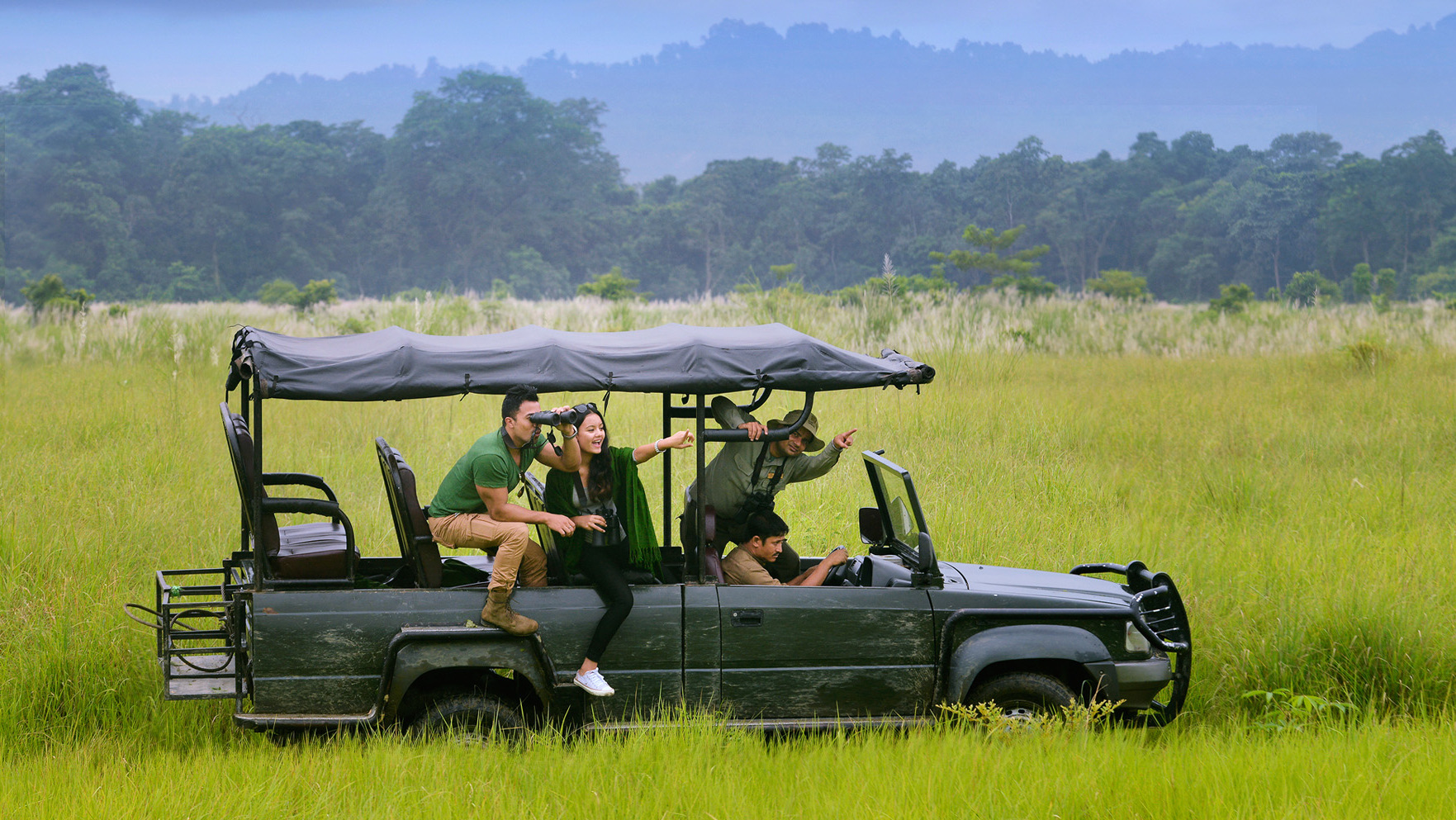
Jungle walks
- Jungle walks, led by experienced guides or naturalists, allow you to explore the park on foot and get closer to nature. These walks are an excellent way to observe smaller wildlife, plants, insects, and birdlife that may be missed during a jeep safari.
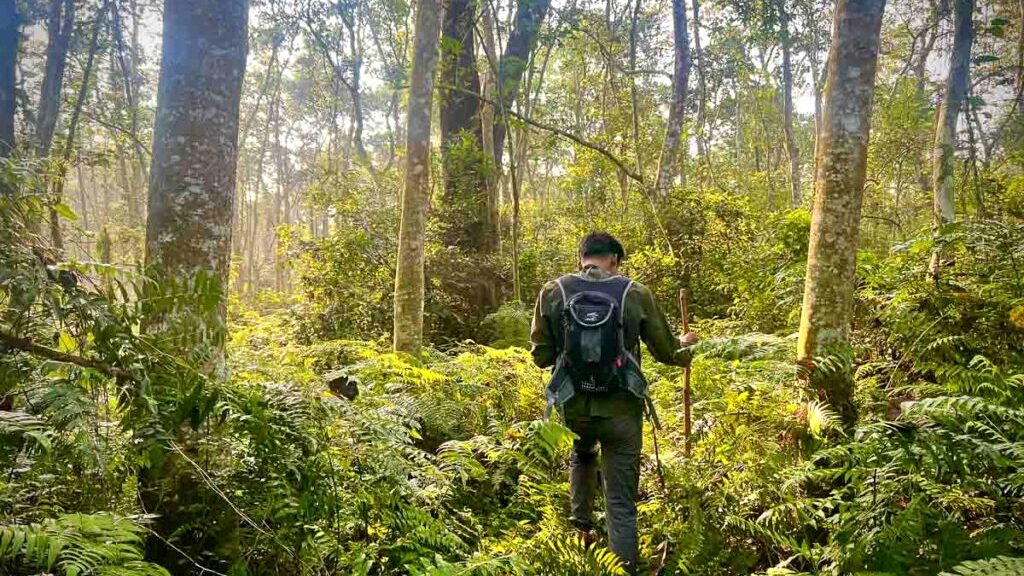
Elephant safaris
- In some national parks, elephant safaris are offered as a way to traverse the dense jungle and grasslands. Riding on the back of an elephant provides a unique vantage point for spotting wildlife, including tigers and rhinoceros.
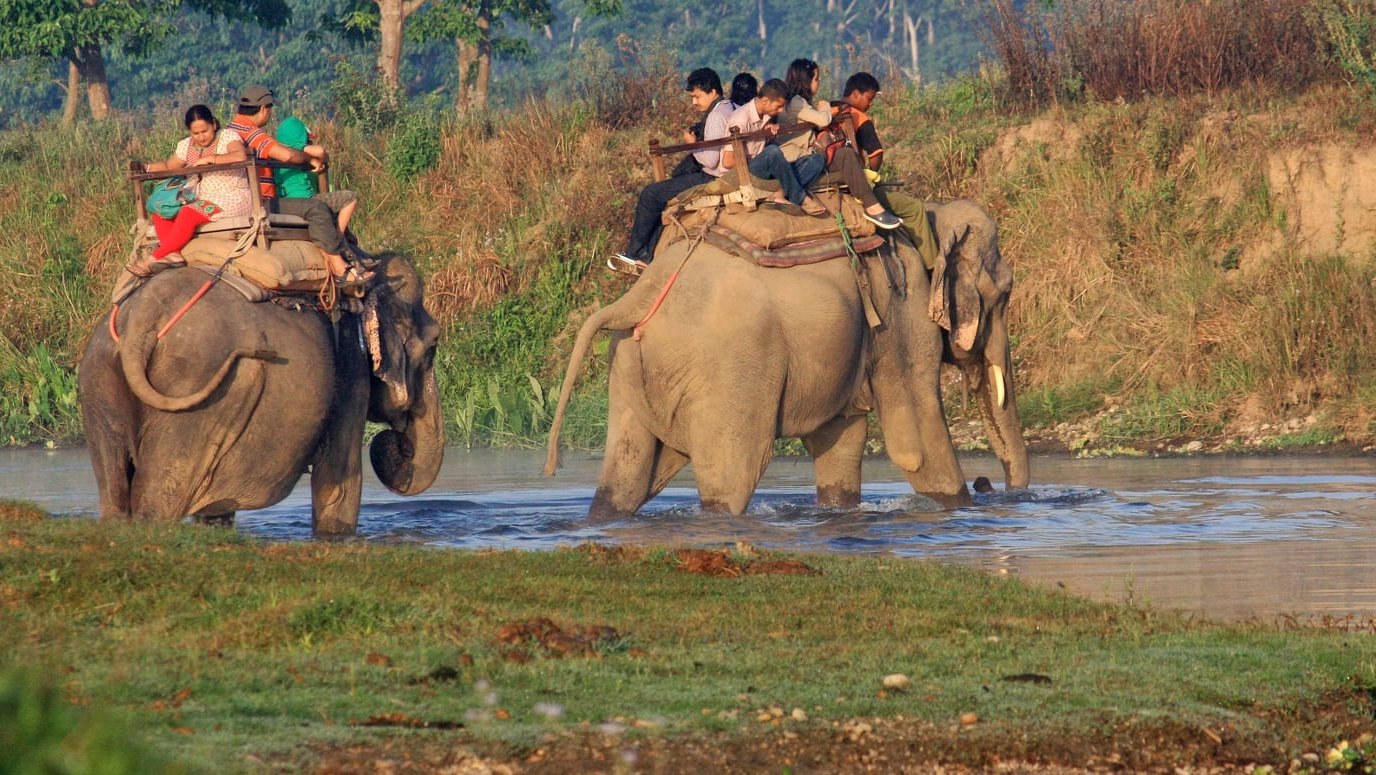
River safaris
- River safaris, usually conducted on canoes or rafts, offer an opportunity to explore the park's waterways and observe aquatic wildlife, such as crocodiles, water birds, and occasionally mammals that come to drink or bathe in the river.

Birdwatching tours
- Nepal is home to a rich diversity of bird species, making it a paradise for birdwatchers. Guided birdwatching tours are available in most national parks and focus on observing and identifying various bird species in their natural habitats.
Village walks and cultural experiences
- In addition to wildlife-focused activities, we offer village walks and cultural experiences, providing insight into the local community's lifestyle and traditions. These activities may include visits to local homes, schools, markets, or traditional dance performances.
Wildlife photography
- For photography enthusiasts, many national parks and lodges offer guided wildlife photography tours or workshops. These activities focus on helping participants improve their photography skills while capturing stunning images of wildlife and landscapes.
When planning a jungle safari in Nepal, consider your interests, adventure level, and time constraints to choose the types of safari activities that best suit your preferences.
If you need any further information, please contact us by email: at [email protected], Phone: at +977- 985 100 5129 (WhatsApp)
Accommodations and Luxury Jungle Safaris
Nepal offers a wide range of accommodations for jungle safaris, catering to various budgets and preferences. From basic lodges to luxurious safari camps, visitors can choose the type of stay that best suits their needs.
Basic lodges and guesthouses
- For budget-conscious travelers, there are simple lodges and guesthouses available in and around the national parks. These accommodations generally provide basic amenities, such as clean rooms, private or shared bathrooms, and local meals.
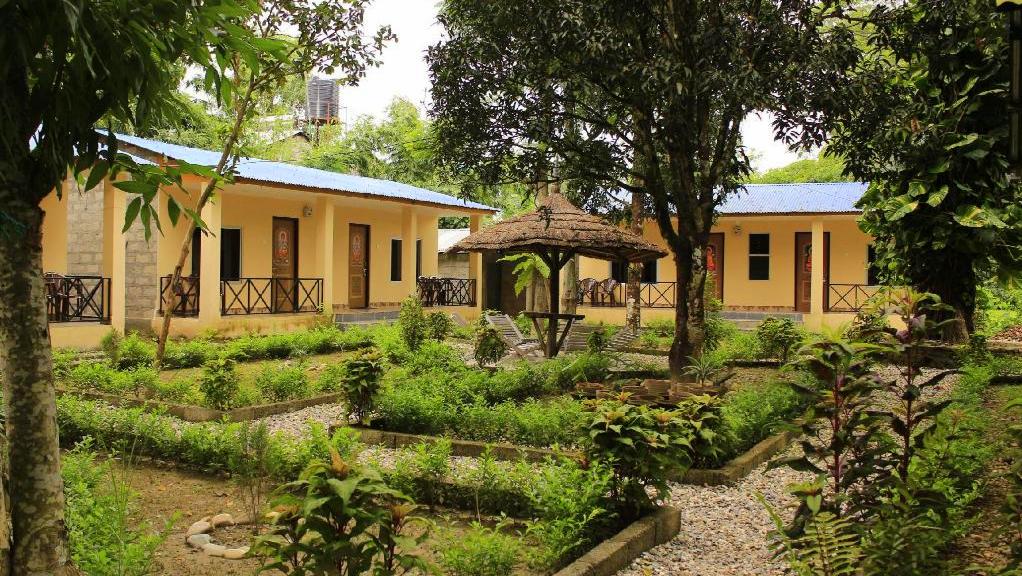
Mid-range hotels and resorts
- Mid-range accommodations offer a higher level of comfort and amenities compared to basic lodges. They usually include private rooms with attached bathrooms, air conditioning, on-site restaurants, and sometimes a swimming pool or other recreational facilities.
Luxury lodges and safari camps
- For those seeking a more indulgent experience, luxury lodges and safari camps offer upscale amenities, personalized services, and exclusive wildlife experiences. Some features of luxury jungle safaris may include:

Luxurious accommodations: High-end lodges and camps often feature spacious and well-appointed rooms, suites, or tented accommodations with comfortable beds, en-suite bathrooms, and stylish furnishings.
Gourmet dining: Luxury safari accommodations usually offer on-site restaurants or dining areas, where guests can enjoy delicious meals prepared by skilled chefs using fresh, local ingredients. Some may even offer private dining experiences or outdoor meals in scenic locations.
Personalized service: Luxury lodges and camps often have a lower guest-to-staff ratio, ensuring attentive service and personalized experiences. This may include tailored safari activities, private guides, or customized itineraries to cater to individual preferences.
Exclusive wildlife experiences: Luxury jungle safaris often provide exclusive wildlife encounters or activities, such as private game drives, guided walks with experienced naturalists, or birdwatching tours with expert guides.
Spa and wellness facilities: Some luxury lodges and camps offer on-site spa and wellness facilities, where guests can relax and rejuvenate after a day of exploring the park.
When planning a jungle safari in Nepal, consider your budget, preferences, and desired level of comfort when choosing accommodations. Luxury jungle safaris provide an opportunity to experience the country's stunning wilderness in style, offering unparalleled comfort and exclusive wildlife encounters.
Getting to the National Parks
Getting to Nepal's national parks and wildlife reserves for jungle safaris typically involves a combination of flights and road transfers. Here's a brief overview of the different transportation options available for the most popular national parks:
Chitwan National Park
- Flight: Fly from Kathmandu to Bharatpur Airport, which takes about 25 minutes. From Bharatpur, it's approximately a one-hour drive to Chitwan National Park.
- Road: Travel by private vehicle or tourist bus from Kathmandu or Pokhara to Chitwan, which takes approximately 5-6 hours.
Bardia National Park
- Flight: Fly from Kathmandu to Nepalgunj Airport, which takes about an hour. From Nepalgunj, it's approximately a 2-3 hour drive to Bardia National Park.
- Road: Travel by private vehicle or tourist bus from Kathmandu to Bardia, which takes about 12-15 hours.
Koshi Tappu Wildlife Reserve
- Flight: Fly from Kathmandu to Biratnagar Airport, which takes about 40 minutes. From Biratnagar, it's approximately a 2-hour drive to Koshi Tappu Wildlife Reserve.
- Road: Travel by private vehicle or tourist bus from Kathmandu to Koshi Tappu, which takes about 10-12 hours.
Parsa Wildlife Reserve
- Road: Travel by private vehicle or tourist bus from Kathmandu to Parsa Wildlife Reserve, which takes about 6-7 hours.
Shuklaphanta National Park
- Flight: Fly from Kathmandu to Dhangadhi Airport, which takes about an hour and 10 minutes. From Dhangadhi, it's approximately a 1.5-hour drive to Shuklaphanta National Park.
- Road: Travel by private vehicle or tourist bus from Kathmandu to Shuklaphanta, which takes about 14-16 hours.
Depending on your destination and preferences, you can choose the most convenient transportation method for your jungle safari in Nepal. Keep in mind that flight schedules may be subject to weather conditions and delays, so it's essential to plan accordingly and have some flexibility in your travel plans.
Packing Essentials for a Jungle Safari
Packing the right items for a jungle safari in Nepal is essential for ensuring a comfortable and enjoyable experience. Here is a list of packing essentials to consider when preparing for your trip:
Clothing
- Lightweight, breathable clothing in neutral colors (greens, browns, and khakis) that blend with the environment
- Long-sleeved shirts and long pants to protect against sunburn, insects, and scratches from vegetation
- A light jacket or sweater for cooler mornings and evenings
- Comfortable, sturdy walking shoes or hiking boots
- Sandals or flip-flops for relaxing around the lodge
- A hat or cap for sun protection
- A rain jacket or poncho during the monsoon season
Accessories
- Sunglasses with UV protection
- Sunscreen with a high SPF
- Insect repellent with DEET or other effective active ingredients
- A reusable water bottle
- A small daypack or backpack for carrying essentials during safari activities
- A travel towel (optional, depending on your accommodation)
Gadgets and gear
- Binoculars for better wildlife viewing and birdwatching
- A camera with a zoom lens for capturing wildlife and landscapes
- Extra memory cards and batteries for your camera
- A portable power bank for charging devices
- A flashlight or headlamp with spare batteries
Personal items
- Personal medications, including any prescription drugs and over-the-counter remedies for common ailments
- (headaches, stomach upsets, etc.)
- A basic first aid kit with adhesive bandages, antiseptic wipes, and any other necessary items
- Toiletries, including soap, shampoo, toothbrush, toothpaste, and any other personal care items
- Wet wipes or hand sanitizer for easy hand cleaning in the field
- A lightweight, quick-drying travel towel (optional, depending on your accommodation)
Travel documents and money
- Passport and visa (if required)
- National park permits and entrance tickets
- Travel insurance documents
- Local currency or a credit/debit card for any additional expenses
By packing these essentials, you'll be well-prepared for your jungle safari in Nepal and ready to fully enjoy the country's stunning landscapes and diverse wildlife.
Park Rules and Regulations
National parks and wildlife reserves in Nepal have specific rules and regulations to ensure the protection of wildlife, their habitats, and the overall ecosystem. Visitors must adhere to these guidelines to minimize their impact on the environment and help maintain the parks' ecological balance. Some general park rules and regulations include:
Entry and permits
- Obtain the necessary permits and entry tickets for the park you are visiting. These are usually arranged by us or can be purchased at the park entrance.
Stay on designated trails
- Do not venture off designated trails or into restricted areas within the park. This helps protect the environment and avoids disturbing wildlife.
Do not disturb wildlife
- Maintain a safe distance from all animals and do not approach, feed, or harass them in any way. Use binoculars or a zoom lens for a closer view without disturbing the animals.
Observe silence
- Keep noise levels to a minimum, as loud sounds can disturb wildlife and negatively impact other visitors' experiences.
No littering
- Do not leave any litter or waste in the park. Carry a small bag or container to collect your trash and dispose of it properly outside the park or at designated waste disposal areas within the park.
No smoking or alcohol consumption
- Smoking and alcohol consumption are generally prohibited within national parks and wildlife reserves.
Do not collect plants or animals
- Do not pick plants, flowers, or fruits, or remove any animals, dead or alive, from the park. Everything in the park is protected and should be left undisturbed.
Camp only in designated areas
- If camping is allowed in the park, set up camp only in designated areas and follow the park's guidelines for campfires, waste disposal, and noise levels.
Respect local customs and traditions
- Some parks may have sacred sites or cultural areas that require specific behavior or dress codes. Follow any guidelines provided by park authorities or local communities.
Follow your guide's instructions
- Our guide is trained and experienced in navigating the park safely and responsibly. Follow their instructions and advice to ensure a safe and enjoyable safari experience.
By adhering to these park rules and regulations, you can help preserve Nepal's national parks and wildlife reserves for future generations while enjoying a responsible and sustainable jungle safari experience.
A jungle safari in Nepal is an unforgettable experience that offers a unique opportunity to explore the country's diverse landscapes and encounter its rich wildlife. By following this comprehensive guide, you'll be well-prepared for your safari adventure and ready to create lasting memories in Nepal's pristine wilderness.
If you need any further information, please contact us by email: at [email protected], Phone: at +977- 985 100 5129 (WhatsApp)